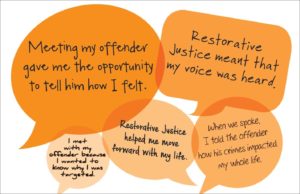This is a guest blog by Bob Neill MP, Chair of the Justice Select Committee (you can follow the work of the committee via its Twitter account: @commonsjustice). You can follow the inquiry on twitter using #RJinq.
The Justice Select Committee introduces inquiry into restorative justice
It is a pleasure to announce the Committee’s inquiry into restorative justice which was launched last week. Our announcement is timely because this week is International Restorative Justice Week.
The Ministry of Justice defines restorative justice as:
the process that brings those harmed by crime, and those responsible for the harm, into communication, enabling everyone affected by a particular incident to play a part in repairing the harm and finding a positive way forward.
We know that restorative justice can provide benefits to both offenders and victims. Victims are given a chance to be heard by the offender and to be involved in approving rehabilitative or reparative activity for the offender. Victims report a high level of satisfaction with restorative justice and it can provide them with a means of closure.
Offenders are given a chance to understand the impact of their crime, apologise, and even to take

action to repair the harm caused. A seven year Government funded research programme found that restorative justice led to a 14% reduction in reoffending and that for every £1 spent on restorative justice, £8 was saved.
The availability of restorative justice is currently the responsibility of a range of separate providers including: Police and Crime Commissioners, the National Probation Service, Community Rehabilitation Companies and Youth Offending Teams. The previous Government gave a commitment to ensure that restorative justice would be embedded in the CJS, and from 2012 published annual action plans.
In the most recent action plan, “Restorative Justice Action Plan: 2014” covering 2014 until 2018, the Ministry of Justice identified four necessary objectives to ensure that good quality restorative justice was easily accessible:
- Ensuring restorative justice is available to victims at all stages of the CJS irrespective of: whether the offender in the case is an adult or a young person; where in England and Wales the victim lives; and the offence committed against the victim.
- To raise awareness of restorative justice and its potential benefits and ensure a consistent understanding of what restorative justice entails and its place in the CJS (messages to reach key target groups including victims, offenders, criminal justice policy developers, leaders and practitioners, the media and the general public).
- To work with PCCs, the NPS, the YJB and prisons to ensure that local mechanisms are in place to so that victims and offenders know how to access restorative justice and can make informed decisions about participating in restorative justice.
- To ensure restorative justice is safe, competent (in line with the EU directive on victims’ rights), focused on the needs of the victim and delivered by a facilitator trained to recognised standards so that it only takes place where an assessment by the facilitator indicates that this would be an appropriate course of action for all relevant parties
The Ministry acknowledged there were a number of issues which may necessitate changes to the action plan’s implementation including:
- emerging findings from the out-of-court disposal pilot;
- awarding of CRC contracts;
- PCCs’ implementation of community remedy documents – which may contain a restorative justice element;
- transposition of the EU Victims’ Directive (which became binding this week);
- and proposals to introduce a Victims’ Law.
We would like to find out what progress has been made in achieving these objectives.
The Conservative Party’s election manifesto promised the introduction of a Victims’ Law – a promise reinforced during the Queen’s Speech which stated that “measures will be brought forward to increase the rights of victims of crime.” The Government has not proceeded with such plans yet.
Under the current Victims’ Code victims of adult offenders are entitled to receive information on restorative justice from the police, including how they could take part. Victims of youth offenders are entitled to be offered the opportunity to participate in it but the Code is clear that for both groups, victim access is dependent on availability in their local area. How these entitlements are working and the potential inclusion of restorative justice in a Victim’s Law are therefore matters of interest for the Committee.
Victims access restorative justice services through Police and Crime Commissioners. Under Transforming Rehabilitation, the delivery of restorative justice which can be accessed by offenders involves the National Probation Service, Community Rehabilitation Companies, as well as the continuing role of Youth Offending Teams and prisons.
Pre-sentence restorative justice was placed on a legislative basis for the first time by the Crime and Courts Act 2013. It made it explicit that the courts could use their existing powers to defer sentencing to allow for a restorative justice activity, provided both victim and offender are willing to participate.
Our Inquiry’s Term of Reference
We welcome submissions by 31st of January addressing this subject. The Committee welcomes views on any aspects of the use or potential use of restorative justice in the criminal justice system, but would be particularly interested in submissions addressing the following points:
- Progress made by the Government in implementing the Restorative Justice Action Plan 2014, including any changes that have been made to this plan
- How the entitlements to restorative justice in the Victims’ Code are working, and their implications for any such entitlements in any future Victims’ Law
- The impact and effectiveness of the National Offender Management Service’s restorative justice programme to promote the development of victim-offender conferencing
- The effectiveness of delivery of restorative justice across the range of service providers and funding arrangements, including provision made by Police and Crime Commissioners, the Prison Service, the National Probation Service, and Community Rehabilitation Companies.
Please note that the Committee may not investigate or intervene in individual cases. Submissions may make reference to individual cases for illustrative purposes, provided they are not the subject of legal proceedings currently before UK courts.
I look forward to receiving your written submission which should be submitted through the portal on the Committee website.









2 Responses
There is no doubt that RJ can be effective – in some cases, in some respects. But there is a constant tendency to over-hype the evidence by RJ ‘believers’. A recent MoJ summary of evidence on ‘what works’ had this to say on RJ:
“What is the impact on reoffending?
Evidence on the effectiveness of restorative justice conferencing is currently mixed/promising. There have been a number of high quality studies and at least one meta-analysis but, because of the variety of other restorative justice models included in the analysis, such as victim-offender mediation, the evidence in relation to any particular model is still relatively weak. However, a large-scale, multi-scheme evaluation in the UK found a reduction of 14 percentage points in the frequency of reoffending among those who received restorative justice conferencing, compared with a comparison group of matched offenders.149 The evaluation also found high levels of satisfaction among victims who participated in the restorative process.
Overall, restorative justice seems most effective when it follows the face-to-face conferencing model150 and when it is applied to certain offences and types of offender. The research to date has identified good results with people who have committed property or violent offences where there is a clear identifiable victim. Offenders with a medium or high risk of reconviction appear to respond well.151
The effectiveness of forms of restorative justice other than that involving conferencing varies widely across studies,152 and there are several studies where reoffending seems to be higher than expected after restorative justice, suggesting that it is not automatically useful.153 To date, there is no reliable evidence on its effectiveness with sex offenders and their victims. There is also a lack of evidence with regard to its use with offenders convicted of intimate partner violence (domestic violence).”
Thus, to pick out the 14% figure – the single most favourable result – is seriously misleading, and leaves a question over Neill’s objectivity.
Although there is much talk about ‘evidence-led’ policy, politicians and for that matter, officials and journalists, tend to support the option that they feel comfortable with and then seek evidence to justify it, rather than look at the evidence first and then make a choice. Some are ‘sure’ that prison, or tagging works – others prefer RJ, counselling etc. The truth is, the truth is rarely straightforward on such matters, and anyone who seems sure of the answers should be listened to with some scepticism.
Anoher aspect is cost. RJ, properly done – and when done on the cheap, it appears less effective – is expensive. In today’s climate, the question is not just whether this or that nostrum works, but how many bangs do you get for your bucks?
Thanks for your comment Julian. Of course, it’s important to remember the benefits to victims of RJ too.